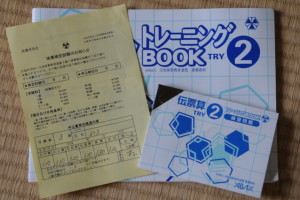 Last Saturday was my 3rd kyu soroban test. For the second and third levels, the test ist not during normal classes anymore, but in a special meeting only for those who take the test. It is still in the normal soroban school; from first kyu on and throughout the dan levels, the test will be administered somewhere else with even more official feeling.
Last Saturday was my 3rd kyu soroban test. For the second and third levels, the test ist not during normal classes anymore, but in a special meeting only for those who take the test. It is still in the normal soroban school; from first kyu on and throughout the dan levels, the test will be administered somewhere else with even more official feeling.
Well, yes, I have passed this test, and now I am a third kyu level in soroban. I did quite well, in fact, I passed every one of the six parts of the test. Besides the usual multiplication, division, and addition/subtraction – all three must be passed – there are three more tests on mental calculation, word problems, and denpyou, where you may fail one of the three and still get an overall passing grade. I usually have problems with the mental calculations – I am too slow – but as I used a slightly different method in the test than the recommended one, I even managed to pass this part of the test.
I think I did quite well, passing four exams in only one year, but I did homework every day, and I believe that from now on the tests will be more difficult. The word problems especially become more difficult, for example on third kyu level all of them boil down to very basic arithmethic, but for second kyu there are now exercises involving percentages and rounding, and more than one simple operation. The other problems stay essentially the same, only the numbers are getting larger. Still, that means a considerable speed up to be able to finish enough exercises in the allotted time.
The next exam will be in two months. I don’t know whether I will become fast enough to try the next level then. We’ll see.

Iris,
Does not using the recommended method for mental calculations mean that you cannot think like a Japanese?
Zinnia
Probably 😉 As Japanese language is more or less upside-down (all the important stuff is at the end of the sentence in the verb), and as language shapes thought and vice-versa… I guess I will never be able to really think like a Japanese.
In this case, however, it’s a bit different: Soroban students learn to do mental calculations by imagining the soroban and imagining manipulating it to get to the answer. If this is the first method you learn with respect to mental calculations, I think it is very easy. For me, in my forties, it is not. I am still using the method I learned in my own childhood, which is essentially to imagine the numbers strung up on a long, endless line. The visualisation obviously makes a difference!
Interestingly, I find subtractions with the soroban method easier than with the line method. I might just get there, eventually?